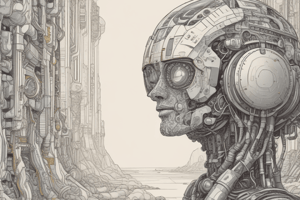Podcast
Questions and Answers
What does the term "situated" refer to?
What does the term "situated" refer to?
Something being placed or positioned in a specific context, environment, or situation.
Which of the following is NOT a way the term "situated" can be understood?:
Which of the following is NOT a way the term "situated" can be understood?:
- Philosophical Perspective (correct)
- Cultural or Historical Context
- Physical location
- Cognitive or Social Context
- Context of circumstance
What does "situated meanings" emphasize about meaning?
What does "situated meanings" emphasize about meaning?
- Meaning is static and universal.
- Meaning is solely based on individual interpretation.
- Meaning is deeply connected to context. (correct)
- Meaning is independent of the situation.
The concept of situated meanings as assemblies suggests that meaning is the product of various factors, forces, or elements coming together in a certain context.
The concept of situated meanings as assemblies suggests that meaning is the product of various factors, forces, or elements coming together in a certain context.
How are "situated meanings as a tool of inquiry" used?
How are "situated meanings as a tool of inquiry" used?
Which of the following is NOT a key feature of "situated meanings as assemblies"?
Which of the following is NOT a key feature of "situated meanings as assemblies"?
What is the key takeaway from the discussion on "situated meanings"?
What is the key takeaway from the discussion on "situated meanings"?
What is the main focus of pragmatics in relation to "situated meanings"?
What is the main focus of pragmatics in relation to "situated meanings"?
Sociolinguistics focuses on how language changes in social contexts, and "situated meanings as assemblies" highlight the importance of social factors in shaping language use.
Sociolinguistics focuses on how language changes in social contexts, and "situated meanings as assemblies" highlight the importance of social factors in shaping language use.
Briefly explain how "situated meanings as assemblies" contribute to discourse analysis.
Briefly explain how "situated meanings as assemblies" contribute to discourse analysis.
Semantics traditionally emphasizes that meaning is context-sensitive and that the meaning of a linguistic unit cannot be fully understood without considering the broader situation.
Semantics traditionally emphasizes that meaning is context-sensitive and that the meaning of a linguistic unit cannot be fully understood without considering the broader situation.
What do the "contextualized processing" and "cognitive flexibility" concepts highlight about situated meanings in psycholinguistics?
What do the "contextualized processing" and "cognitive flexibility" concepts highlight about situated meanings in psycholinguistics?
Anthropological linguistics emphasizes that language use is influenced by cultural and environmental contexts, and "situated meanings as assemblies" support this view by highlighting the importance of cultural norms, rituals, and social structures in shaping meaning within those contexts.
Anthropological linguistics emphasizes that language use is influenced by cultural and environmental contexts, and "situated meanings as assemblies" support this view by highlighting the importance of cultural norms, rituals, and social structures in shaping meaning within those contexts.
The historical model of sex and gender emphasizes that there are only two sexes (male and female) and two genders (man and woman).
The historical model of sex and gender emphasizes that there are only two sexes (male and female) and two genders (man and woman).
The Victorian Era saw a medicalization of gender, leading to a focus on categorizing individuals as "normal" or "abnormal" based on their sex characteristics.
The Victorian Era saw a medicalization of gender, leading to a focus on categorizing individuals as "normal" or "abnormal" based on their sex characteristics.
The rise of feminist and LGBTQ+ advocacy groups in the 1960s began challenging the rigid binary model of sex and gender, leading to greater recognition of the social construction of gender and the idea that gender identity is distinct from biological sex.
The rise of feminist and LGBTQ+ advocacy groups in the 1960s began challenging the rigid binary model of sex and gender, leading to greater recognition of the social construction of gender and the idea that gender identity is distinct from biological sex.
What are some key impacts of the historical model on intersex people?
What are some key impacts of the historical model on intersex people?
The evolution of our understanding of intersexuality reflects the broader historical changes in how sex, gender, and sexuality are understood.
The evolution of our understanding of intersexuality reflects the broader historical changes in how sex, gender, and sexuality are understood.
What are some of the key aspects of diversity?
What are some of the key aspects of diversity?
Diversity alone guarantees a fair and just society.
Diversity alone guarantees a fair and just society.
Which of the following is NOT a key aspect of inclusivity?
Which of the following is NOT a key aspect of inclusivity?
Historical context is important for understanding the meaning and implications of events, ideas, and phenomena.
Historical context is important for understanding the meaning and implications of events, ideas, and phenomena.
What are the key factors that contribute to historical context?
What are the key factors that contribute to historical context?
Cultural models are universal.
Cultural models are universal.
What are some key features of cultural models?
What are some key features of cultural models?
Which of the following is NOT a type of cultural model?
Which of the following is NOT a type of cultural model?
Cultural models are always static and unchanging.
Cultural models are always static and unchanging.
What is the main takeaway from the discussion on "cultural models"?
What is the main takeaway from the discussion on "cultural models"?
Flashcards
Situated
Situated
The placement or position of something within a specific environment or context.
Situational Meanings
Situational Meanings
The idea that meanings are not fixed or absolute, but are shaped by the context in which they are used.
Situated Meanings as Assemblies
Situated Meanings as Assemblies
The process of meaning being formed through the interplay of various factors, like social, cultural, historical, and personal influences, within a specific context.
Assemblies
Assemblies
Signup and view all the flashcards
Context Dependent
Context Dependent
Signup and view all the flashcards
Situated Meanings as a Tool of Inquiry
Situated Meanings as a Tool of Inquiry
Signup and view all the flashcards
Context-Dependent Meaning
Context-Dependent Meaning
Signup and view all the flashcards
Binary Model
Binary Model
Signup and view all the flashcards
Intersex
Intersex
Signup and view all the flashcards
Historical Model
Historical Model
Signup and view all the flashcards
Normalization (Intersex)
Normalization (Intersex)
Signup and view all the flashcards
Diversity
Diversity
Signup and view all the flashcards
Inclusivity
Inclusivity
Signup and view all the flashcards
Historical Context
Historical Context
Signup and view all the flashcards
Historical Context
Historical Context
Signup and view all the flashcards
Anachronism
Anachronism
Signup and view all the flashcards
Cultural Model
Cultural Model
Signup and view all the flashcards
Cognitive Frameworks
Cognitive Frameworks
Signup and view all the flashcards
Shared and Collective
Shared and Collective
Signup and view all the flashcards
Dynamic and Evolving
Dynamic and Evolving
Signup and view all the flashcards
Influence on Behavior and Identity
Influence on Behavior and Identity
Signup and view all the flashcards
Gender Norms
Gender Norms
Signup and view all the flashcards
Moral and Ethical Frameworks
Moral and Ethical Frameworks
Signup and view all the flashcards
Cultural Models of Health and Medicine
Cultural Models of Health and Medicine
Signup and view all the flashcards
Family Structures
Family Structures
Signup and view all the flashcards
Globalization
Globalization
Signup and view all the flashcards
Social Movements
Social Movements
Signup and view all the flashcards
Study Notes
Situated Meanings
- "Situated" refers to something's placement within a specific context, environment, or situation. Its meaning varies based on usage.
- Physical location: Describes a thing's position in space.
- Context or circumstance: Refers to the setting or conditions surrounding an event, action, or object.
- Cognitive or social context: Focuses on knowledge, learning, or actions within a particular environment.
- Cultural or historical context: Places events or objects within cultural, historical, or social frameworks.
Situated Meanings as Assemblies
- Situated meanings are products of interacting factors (social, cultural, historical, personal) within a specific context.
- Assemblies highlight the interdependence of various aspects within a situation, rather than solely based on individual interpretations.
- Meaning arises from the interaction of context, people, environment, and objects.
- Examples include meetings, discussions, or events where the meaning is co-created by all participants.
Situated Meanings as a Tool of Inquiry
- Meaning is a subject for investigation within the context where it's formed or used.
- Researchers use situated meanings to probe how people understand the world within specific circumstances.
- Meaning is context-dependent, not fixed or objective.
- Meaning is explored within the specific settings where experiences and practices occur.
Context Dependence
- Meanings are not absolute but are deeply influenced by their context.
- A single word or action can have various meanings, depending on the surrounding situation.
- Social and material factors (cultural, relational, historical, physical, technological, spatial) shape meaning.
- Meaning is constantly evolving and shaped by new elements entering the situation.
Emergent and Dynamic Meaning
- Assemblies of meaning are not static; they evolve over time.
- New elements can enter a situation, causing existing elements to change and therefore affecting meaning.
- Dynamic interaction among components is crucial for understanding situated meaning.
- Example: A workplace ritual's meaning changes as new employees join or organizational values shift.
Multiple Perspectives
- Different individuals interpret situations in varying ways, based on unique experiences, roles, and relationships.
- Meaning is plural and multifaceted, shaped by unique perspectives.
- Examples in a community event, the meeting will have different meanings for organizers, participants, and spectators.
Sociolinguistics
- Sociolinguistics studies how language varies and changes in social contexts.
- Situated meanings help understand language use as shaped by social, cultural, and historical contexts.
- Social contexts profoundly influence the meaning of a word or phrase.
- Example: A word's meaning changes based on gender, age, or ethnicity.
Discourse Analysis
- This examines language use in communication (conversations, texts, media).
- Meaning is embedded in the surrounding situation which influences the interaction amongst elements.
- Textual and contextual relationships highlight meaning’s crucial dependence upon context.
- Example: Texts are not isolated, but are influenced by precedents and discourse traditions.
Semantics
- Semantics traditionally considers the meaning of words, phrases, and sentences in their contexts.
- Situated meanings emphasize the context-sensitivity of meaning.
- Word meaning varies based on the situation.
- Compositional semantics emphasizes how meanings emerge from components but situations impact the significance of sentences or utterances.
Psycholinguistics
- Psycholinguistics explores how humans process language.
- Meaning emerges from interactions of context and words and phrases presented.
- Contextualized processing explains people drawing on various contextual clues to determine meaning.
- People's brains are flexible in processing meaning, given various changing contextual situations.
Anthropological Linguistics
- This studies how language is related to culture, influenced by cultural and environmental contexts.
- Cultural context shapes meaning, as words and behaviors carry different meanings in diverse cultures.
Intersexuality
- Intersexuality refers to individuals born with sex characteristics that don't fit typical male or female norms.
- Historical models categorized intersex as abnormalities or deviations, requiring medical intervention to conform to gender binaries.
- Modern perspectives acknowledge intersexuality as a natural variation in human biology.
- These perspectives highlight that meaning is dependent upon the historical context.
Diversity and Inclusivity
- Diversity refers to the variety of differences among individuals.
- Inclusivity is fostering an environment where all feel valued, regardless of background.
- Key aspects include representation, equity, respect, support, and safe spaces.
- Inclusivity and diversity are essential for empowerment, participation, dismantling inequalities, and fostering innovation.
Globalization, Social Movements, and Cultural Exchange
- Globalization exposes people to different perspectives and cultures, potentially leading to both blending and challenges of existing models.
- Social movements (e.g., feminism, LGBTQ+ rights) challenge traditional models and create more inclusive ones.
- Technological advances (e.g., social media) reshape cultural models.
- Cultural exchange and interactions shape and evolve cultural models over time.
Historical Context
- Historical context refers to circumstances and conditions shaping ideas, actions, and events.
- It’s essential for understanding the meaning, implications of events.
- Context includes political, social, economic, cultural, technological, and geographical factors.
- Historical context helps avoid anachronism (judging past events with present values).
Cultural Models
- Cultural models are frameworks/cognitive schemas enabling people to interpret the world.
- They shape beliefs, behaviors, and societal norms.
- Cultural models are shared, collective, dynamic, and evolve over time.
- Example: Gender roles, time concepts, and expressions of success.
Studying That Suits You
Use AI to generate personalized quizzes and flashcards to suit your learning preferences.




